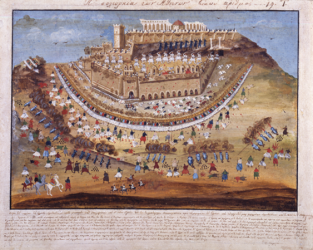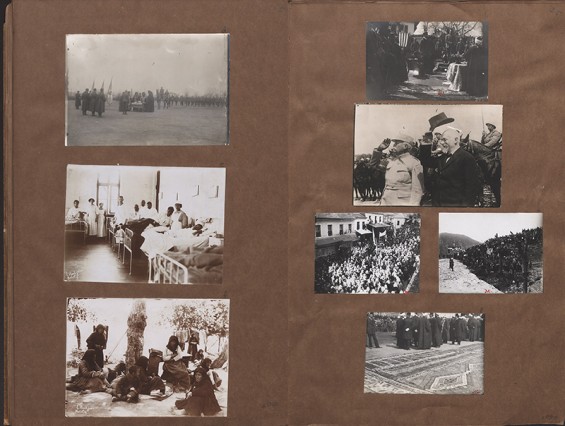Modern Greek History
War of Independence
The section on the War of Independence (1821-1829) contains a wide variety of works, including eyewitness accounts of many participants, Greeks and Philhellenes alike. Among the Greek works the memoirs of Kolokotrones and Makriyannis are outstanding, and among the Philhellenes, Lester Stanhope, Samuel G. Howe, and James Emerson. The Library also contains many pamphlets addressing the critical period of the struggle for independence, from both Greece and other countries. In addition to the material that deals with the historical facts, this section also includes information about the Philhellenic movement, diplomatic transactions, biographies, cartography, pictorial representations and memorials, poetic, dramatic and romantic works on the War and manuscripts.

Makriyannis Paintings
Among the treasures of the collection is a series of paintings illustrating episodes in the Greek War of Independence, executed for General Ioannis Makriyannis by the artists Panayiotis and Dimitrios Zografos in 1836-1839. The scenes were originally painted on wood, and were then copied in four sets on paper. These scenes were presented to the monarchs of the countries involved in the War: King Otto of Greece, Tsar Nicholas II of Russia, Queen Victoria of England, and Louis Philippe of France. Of these four presentation copies, only the one in the Gennadeion (which belonged to King Otto) and Queen Victoria’s now in Windsor Castle, are known.

Lord Byron
The Gennadius Library features an impressive collection of Byroniana. George Gordon, aka Lord Byron, was the most famous of the Philhellenes and his poetry and untimely death did much to arouse sentiment in favor of the Greek Revolution. It is natural, therefore, that Gennadius was interested in Byron and collected the works of the great poet and books about him. The rarest piece is the four-line verse written by Byron in 1818 on the birth of a son to the English consul in Venice. The text was translated into eleven languages and printed, apparently in ten or less copies. The Gennadeion copy is signed by the child’s godfather, Count Rizzo, and presented to the mother. The Library has also a number of books once owned by Byron himself, including the two copies of the 1640 edition of the Iliad translated into demotic Greek, evidence of the young poet’s interest in the spoken language. There are also many illustrations for Byron’s poetry, some of them original, and the last portrait of the poet, a watercolor, executed from a sketch made just before Byron’s death at Messolonghi. A number of the Byron memorabilia are also in this collection: a lock of the poet’s hair; his manuscript case with initials; a visiting card tray; several seals; a watch; a piece of his tartan jacket worn at Messolonghi; and an unfinished embroidery by his half-sister Augusta Leigh. Probably the most moving item of all is the crown of laurel leaves and Greek flowers sent by the people of Messolonghi and placed on the poet’s body as it lay in state in London.
Adamantios Koraes
A key figure in the history of Modern Greece is Adamantios Koraes (1748-1833), who was one of the most prominent intellectual figures of the Greek national revival in the first decades of the 19th century. Koraes felt that the first requisite for the development of national solidarity and consciousness was a common language and he furthered the Greek Revolution by issuing popular editions of the classics. The Gennadius Library collection includes almost all editions of these volumes, and a wide selection of secondary literature about Koraes.
Kingdom of Greece
Under the heading ‘Kingdom of Greece,’ Gennadius put all publications dealing with the history of Greece after it became an independent state, its political institutions, and its government. This section also contains a very good collection of laws and statutes of several organizations and institutions, dating approximately from the middle of the nineteenth century and on until the first three decades of the twentieth century.
The ‘Eastern Question’
Gennadius had a very extensive and comprehensive collection of pamphlets, review articles and other treatises on the most intractable problem of 19th-century European diplomacy. The ‘Eastern Question’ started in 1774 with the Küçük Kaynarca treaty between Russia and Turkey and ended in 1923 with the treaty of Lausanne. In between those years some of the most important events in world history and international relations took place: the Napoleonic wars, the Greek War of Independence, the Crimean War, World War I.

Balkan Wars through the Scrapbooks of Joannes Gennadius
The scrapbooks of Joannes Gennadius are one of the most important collections of the Gennadius library, because they contain invaluable information for the history of modern Greece. In his scrapbooks, Gennadius collected photos and other ephemera (clippings from newspapers and books, engravings, printed matter, broadsides, invitations and many other materials). The 116 volumes of the scrapbooks focus on diverse topics: historical, topographical, archaeological, ethnological (costumes), architectural, art historical, history of the book, journalistic as well as the Gennadius family.
Explore the Scrapbook of John Gennadius for the Balkan Wars of 1912-1913